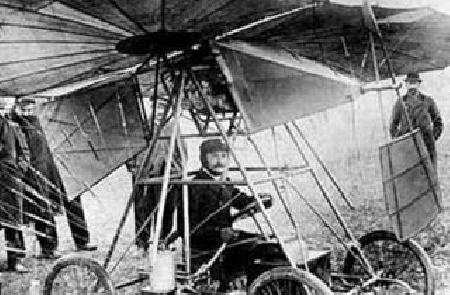Traian Vuia
Together with Aurel Vlaicu and Henry Coanda, Traian Vuia is one of the pioneers who shaped the aeronautic history of Romania in early 20thCentury.

Steliu Lambru, 22.03.2013, 13:31
Together with Aurel Vlaicu and Henry Coanda, Traian Vuia is one of the pioneers who shaped the aeronautic history of Romania in early 20thCentury. The three men are all known to have invented, tested and flown aircraft. Vuia became the first Romanian who tried to fly a machine he had built himself on March the 18th1906 in Montesson, near Paris. For a long time he was known as the first pilot of a heavier-than-air flying machine. Although some still continue to believe in this story, we know today that it was a myth put up by the communist propaganda structure, as Vuia was a well-known communist sympathizer. And in order to learn the truth we have to pay attention to the reaction triggered back then by his attempt to take off in a heavier-than-air flying machine.
A lawyer by profession, Vuia lacked any technical training, but his great passion for engines and mechanics eventually paid off, allowing him to come up with several inventions in aeronautics and other fields. In 1905 he completed his first plane, Vuia One, also known as “The Bat”, which he tested himself on the field of Montesson. After running for 50 meters, the plane went up one meter hovering only 12 meters because the engine wasn’t strong enough to take it higher. As aviation historian Bernard Orna wrote back in 1956, Vuia One was hit by a gust of wind and got damaged at the impact with a tree.
In spite of the apparent failure, the local press and all eyewitnesses continued to show their support for the Romanian pioneer. The French Airclub’s magazine L’Aerophile, underlined the fact that the plane was able to take off and get airborne by itself, and needing neither a catapult nor a vehicle to pull it along the airfield. Vuia had to add more power to the engine and improve the plane’s controls. He bounced back from the first failures and came up with new projects, Vuia One Plus and Vuia Two, in 1907. He struggled to get airborne again in August and October that year but failed. However, his modest accomplishments won him acclaim from the eyewitnesses as well as from those who carried out similar projects after him. Another aviation pioneer, Brazilian Alberto Santos Dumont admitted that Vuia was a groundbreaker for the coming generations of airmen.
Traian Vuia gave up his experiments after the failures he had in 1906-1907, but returned to the airstrip a decade later, to test two helicopter prototypes, which also proved unsuccessful. The Romanian inventor had more success with a steam generator, which he patented in 1925 and is still in use in some power plants nowadays.
Traian Vuia wasn’t only an inventor and builder of flying machines; he also got involved in politics, actively supporting the interests of the Romanians from Banat and Transylvania, which belonged to Austria-Hungary at that time. Although a staunch supported of the union of the territories inhabited by the Romanians with the Kingdom of Romania, Vuia believed that unification without guarantees for the autonomy of Banat and Transylvania was not a feasible project. Discontented with the political developments in Romania, Vuia withdrew from the Romanian lobbying organizations in France, but he didn’t completely give up on politics. In the occupied France of 1943, Vuia founded the Romanian National Front, an antifascist organization linked to the French Resistance. Nearly 170 Romanians out of 14 thousand living in France under the Nazi occupation joined the Resistance, and the communist campaigner Olga Bancioc was executed in 1944. Vuia was one of those spoiled by the communist regime after the war, and he was known for being one of Prime Minister Petru Groza’s closest friends. He was accepted as a member of the Romanian Academy in 1946, at a time when the communist authorities exerted maximum pressure upon the state institutions. After the consolidation of the communist regime and after 44 years spent in the West, Vuia came back to Bucharest where he died in 1950 at the age of 78.






























